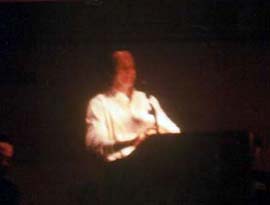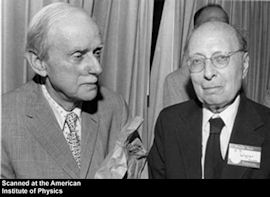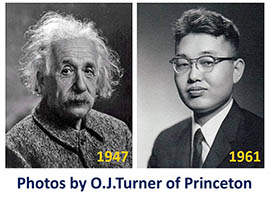Soft Spots in Dirac's Papers
and Feynman's Papers
Both Dirac and Feynman made their life-long efforts to make quantum
mechanics consistent with special relativity.
Click here for a story.
However, they left some
soft spots in their papers. Indeed, those soft spots are excellent
homework problems for us.
On the issue of the Poincaré group
- Dirac was mostly interested in bound-state problems and localized
probability distributions. He used harmonic oscillators whenever
appropriate. In his 1949 paper on the Forms of Relativistic Dynamics in
Rev. Mod. Phys. 21 , 392 (1949), Dirac stated that
the task of formulating relativistic quantum mechanics is equivalent
to constructing a suitable representation of the Poincaré group.
If this is so, why did he not use harmonic oscillators to construct the desired representation? Why did he not talk with his brother-in-law about the problem? His brother-in-law was Eugene Wigner who started constructing representations of the Poincaré group in 1939.
Yes, this creates an interesting homework problem for us. Click here for the solution of this problem.

Feynman giving his talk at the 1970 APS Spring Meeting in Washington. His talk was completely crazy to most of the audience, but not to me. - Feynman invented Feynman diagrams, but he realized that his diagrams
are applicable only to scattering processes where the particles are free
in the remote past and remote future. In
his 1970 talk, for bound
states, Feynman told us to use harmonic oscillators instead of Feynman
diagrams.
He then published his talk with his students in Phys. Rev. D 3, 2706 (1971). However, this paper is thoroughly self-inconsistent from the mathematical point of view, and they even make apologies. However, their mathematics can be fixed up. If this is done, the mathematics is a representation of the Poincaré group based on harmonic oscillators, given in the paper that fixes up Dirac's soft spot mentioned above. Click here again.
- Here is a graphical illustration of where Wigner and Feynman stand in Einstein's world.

|
|
Photo from the AIP E. Segre Visual Archives.
Dirac and Wigner were brothers-in-law.
Click here for a story. These two brothers-in-law seldom talked about physics. |
On the issue of the time-separation variable
-
The Bohr radius is a very important quantity in quantum mechanics. It is
spacial separation between the proton and electron in the hydrogen atom.
If the hydrogen atom starts to fly, we have to worry about it time
separation. This concept does not exist in the present Copenhagen
interpretation of quantum mechanics. Indeed, this time-separation is
one of the hidden variables in the present form of quantum mechanics.
- Paul A. M. Dirac worried about the time-energy uncertainty as
in 1927 when Heisenberg's uncertainty relation was inaugurated.
[Proc. Roy. Soc. (London) A114, 243 (1927)]. He talked about
the relation between the life time and line broadening.
In 1945, Dirac attempted to construct a representation of the Lorentz group with four-dimensional oscillators [Proc. Roy. Soc. (London) A183 , 284 (1945)]. His wave functions are localized in both space and time variables. Presumable, his space variables are separation variables in the hydrogen atom, but Dirac never mentioned the time separation for the time variable.
- Richard Feynman, in his 1971 paper with his students, noted the
existence of the time-separation, but he did not do anything
about it. His reason was very simple. He does not know what to
do about it.
- Indeed, the time-separation variable is one of my major research
subjects for many years. According to Einstein, this is clearly
a physical variable, but it does not exist in the present Copenhagen
formulation of quantum mechanics. Thus is the time separation is
qualified to become a hidden variable. The failure to observe
this variable leads to an increase in entropy. Among the many
papers I wrote on this subject, you may look at
- Kim and Wigner in
Phys. Lett. A 147, 343 (1990).
- Kim and Noz in Symmetry 3, 16 (2011).
- Kim and Wigner in
Phys. Lett. A 147, 343 (1990).

| |
|
- Click here for his home page.
- His Einstein page.
- Princeton page.
- His style page.